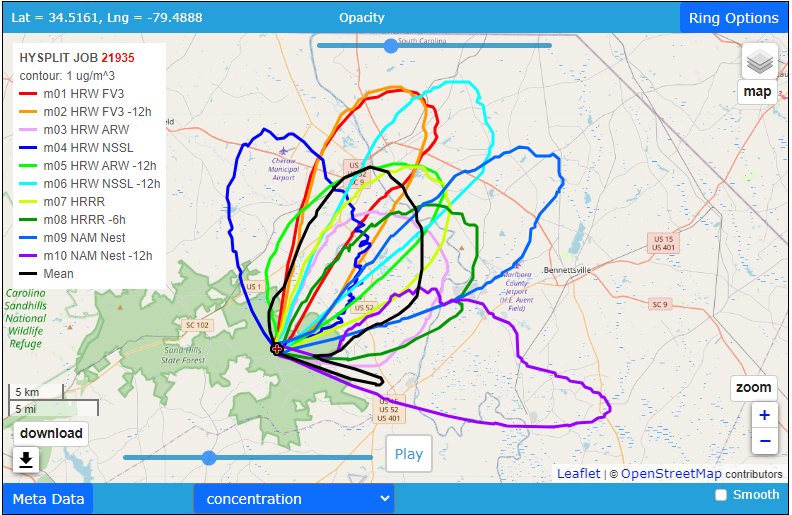ARL Weekly News – July 14, 2023
| Recent Events |
HYSPLIT Adds Robust Probabilistic Forecast Capability
Forecasting now includes option for ten member ensemble Meteorology.
Air Resources Laboratory deployed a probabilistic forecast feature to NWS HYSPLIT on July 7, 2023. This new feature utilizes the ten-member ensemble meteorology provided by the NOAA’s High Resolution Ensemble Forecast (HREF) system. NWS HYSPLIT is a software application that provides National Weather Service (NWS) meteorologists with trajectory and dispersion modeling for emergency response applications. HYSPLIT modeling of the event is carried out with each of the ten members, and uncertainties in HYSPLIT predictions due to variations in meteorology may be gauged using the differences in forecasts among the different members.
For this update, parallel computation schemes were implemented so that the results of the ensemble system simulations can be obtained in a wall-clock runtime comparable to non-ensemble runs. Features in the graphical display have been added to enable visual comparison of trajectories or dispersion plumes among the different ensemble members. For dispersion runs, the mean and additional probabilistic plots of the ten-member results are also available. Simulation of chemical dispersions, generic dispersions, prescribed burns, and air-parcel trajectories are supported.
Timely support from NOAA Web Operation Center in resolving operational issues that arose during this implementation is gratefully acknowledged. Example outputs from a hypothetical prescribed burn event are shown below. (Sonny Zinn, Mark Cohen, Alice Crawford, Barbara Stunder – retired)

PM 2.5 ensemble predictions for a hypothetical prescribed burn. Contour lines at PM 2.5 concentration of 1 µg/m3 from each ensemble member prediction are drawn in different colors. Note the mean of all ensemble members is drawn in black.
U of Md. Presentation on Atmospheric Modeling
Mark Cohen gave an invited presentation regarding atmospheric modeling and career development to two classes at the Univ of MD in the First-year Innovation and Research Experience (FIRE) program. One of the courses, taught by Prof. Thanicha Ruangmas, was in the Sustainability Analytics area, and this course has been using the HYSPLIT model for several years. The other course was in the Climate Computing area, taught by Professor Sara Strey.
Media Mentions
Wired Magazine’s article on the heat dome featured quotes from ARL’s Howard Diamond. The Heat Wave Scorching the US Is a Self-Perpetuating Monster
July 12 was the UN’s Inaugural International Day of Combating Sand and Dust Storms, which coincided with the International Conference on Aeolian Research. A visualization by Barry Baker was shared to NOAA Research social media and well received, with up to 30,000 impressions. Instagram Twitter

NACC-Cloud Available on High-Performance Computing platform
ARL’s Drs. Patrick Campbell, Rick Jiang, Zachary Moon, Sonny Zinn, and Youhua Tang (ARL-ASMD) co-authored a paper on NOAA’s Global Forecast System Data in the Cloud for Community Air Quality Modeling, which was published as an open-access article in the journal Atmosphere on July 4, 2023. The development and use of the NOAA-EPA Atmosphere-Chemistry Coupler (NACC)-Cloud Version 1 in this work are critical to provide the scientific community streamlined access to NOAA’s operational GFSv16 data and user-defined processing and download of model-ready, meteorological input for any regional Community Multiscale Air Quality (CMAQ) model domain worldwide. The NACC-Cloud system was implemented on the Amazon® Web Services High-Performance Computing platform, and results from this work show that the NACC-Cloud system is immediately beneficial to the air quality modeling community worldwide.
| Publications |
Accepted: Intimately tracking NO2 pollution over the NYC – Long Island Sound landwater continuum: An integration of shipboard, airborne, satellite observations, and models
Tzortziou, M., C.P. Loughner, D. Goldberg, L. Judd, D. Nauth, C.F. Kwong, T. Lin, A. Cede, and N. Abuhassan, 2023, Intimately tracking NO2 pollution over the NYC – Long Island Sound landwater continuum: An integration of shipboard, airborne, satellite observations, and models, Science of the Total Environment, 897, 165144, https://doi.org/10.1016/j.scitotenv.2023.165144.

